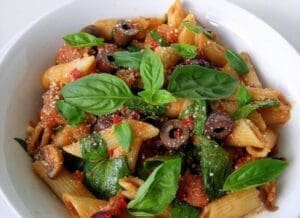6 Ways to Lighten Your Pasta Load

It’s estimated that the average restaurant serving of pasta contains anywhere from 4 to 7 cups of pasta—that’s up to 350 grams of carbohydrates in a single sitting! Mind you, we’re recommended to consume just 250 grams of carbs in a full day. That bowl of pasta is packing one massive dose of carbs (not to mention calories), and unless you are a pro athlete, those carb’s are going to turn to fat. Period.
Sadly, we’ve become so accustomed to these large portion servings that even when cooking pasta at home, we tend to go way overboard with how much pasta we actually use. Did you know that a single recommended serving of pasta is just ½ cup dried, or 1 cup cooked? That’s your serving. I know, laughable. But with a few tweaks of your fave pasta recipes, you can learn how to lighten your pasta by bulking up on leaner options, making a better sauce and including proteins. Check out these six tips for making a lighter pasta.
- Use whole grains. Regardless of what pasta you’re going for, choose whole grain—always! Whole grain pasta offers fiber (which fills you up faster), protein (which keeps you full longer) and loads of minerals (which get lost in the processing to make white pasta). Go beyond whole wheat and try pastas made from quinoa, brown rice, millet or buckwheat.
- Bulk it up with greens. Replace about ½ the dry pasta you would normally use (anywhere from ½ to 1 cup) with twice as much greens. In virtually any pasta recipe (save anything with stuffed shells like lasagna or manicotti), the greens can serve the same purpose as noodles do in holding sauce, carrying herbs and making for fork-winding fun. Great greens to use in pasta include arugula, thinly sliced kale, baby spinach, watercress, and finely chopped broccoli. Add them to the boiling pasta for just about 30 seconds before it is done cooking so they can cook in the same liquid; drain with the pasta and toss with your preferred sauce. When using leafy greens, keep in mind that they shrink to incredibly small proportions when cooked, so don’t be afraid to add several cups into the mix to get the full bulking benefits.
- Add lean protein. Pasta salads are a great example of pasta recipes that can benefit from added lean protein. Add a few strips of baked chicken, flaked broiled fish or cubed baked tofu to your pasta, and reduce the amount of total pasta used in your dish. Now you’re cutting back on excess carbohydrates while increasing your protein intake, making for a more balanced meal. In my pasta salads, I’ll use only a ½ cup or so of actual pasta, and then fill the rest of the mixing bowl with chopped vegetables, fresh herbs, beans and a bit of fish or chicken.
- Chunk up the sauce. Steering away from store-bought sauces, which are often full of added sugars (and thus empty calories), make a from-scratch robust pasta sauce with ample tomatoes, peppers and seasonal vegetables. Take whatever’s fresh in your neighborhood (be it chopped mushrooms, broccoli, eggplant, you name it!) and sauté in olive oil until nice and softened; add chopped tomatoes and/or tomato paste, a bit of wine and/or stock and desired seasonings; add water to reach desired consistency; and pour over pasta. The chunkier you make your sauce with extra cooked veggies, the less pasta you’ll need to use, as you’ll be getting huge forkfuls of fiber-rich sauce instead of carb-rich pasta.
- Add fresh herbs. Herbs have a beautiful place in pasta. They don’t necessarily serve to “bulk” up your recipes the way that vegetables can, but they provide lots of flavor so you can reduce the amount of heavy sauce you would normally use. Let’s take the beloved macaroni and cheese, for example (which isn’t really Italian cuisine, but heck, it’s pasta). Your fave recipe for the dish might be loaded with three cheeses, heavy milk and a few pads of butter. But by sprucing up your sauce with fresh herbs, particularly basil, parsley, rosemary or thyme, you can reduce the amount of that sauce you add to your cooked pasta—because now you’re getting delicious flavor from herbs and not solely relying on cheese sauce for the yummy tang.
- Replace the dairy. And speaking of heavy cream sauces, you can reduce your overall fat and calorie load by replacing the dairy with leaner substitutions. In your recipes for cream-based sauces such as Alfredo or macaroni and cheese, replace the cream with hemp or almond milk, as they have a naturally thick consistency. Replace the butter called for with olive oil, using ¾ of the butter called for and eliminating the saturated fats. For heavy cream-cheese sauces, also try pureed silken tofu, which is incredibly low in fat and calories and supplies lean protein and calcium.
Image: jamieanne

